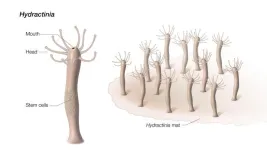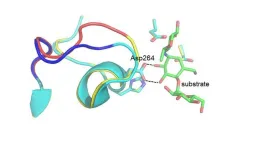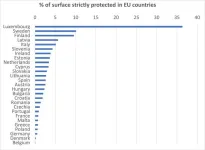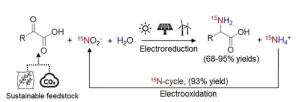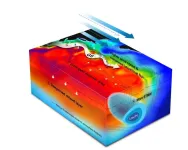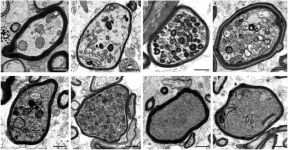(Press-News.org) A $7 million study beginning this summer at Wake Forest University and Wake Forest University School of Medicine will help determine whether a combination of resistance training plus bone-strengthening exercises and/or osteoporosis medication use can help older adults safely lose weight without sacrificing bone mass.
That paradox – that shedding pounds can help stave off heart disease and diabetes while increasing bone loss and subsequent fracture risk – has been a focus of Wake Forest researcher Kristen Beavers for about a decade.
Her previous research has considered how resistance training helps offset bone and muscle loss associated with weight loss, and how wearing a weighted vest, a type of bone-loading activity, might help offset bone and muscle loss while dropping fat. When you apply load to your bones, through anything from walking to stair climbing, it tells the body to slow the bone loss that occurs naturally as we age.
The addition of a first line osteoporosis drug like alendronate, a bisphosphonate medication which goes by the brand name Fosamax, was the next logical step, she said.
“Bisphosphonates are FDA-approved medications that have been used for a long time to prevent and treat osteoporosis, which is age-related bone loss,” said Beavers, an associate professor in the Department of Health and Exercise Science and a principal investigator for the Bone, Exercise, Alendronate, and Caloric Restriction (BEACON) Trial.
She said the mechanisms driving age-related bone loss are not so dissimilar from those driving weight loss associated bone loss. She is hoping that results from the BEACON trial show these drugs can be repurposed to help preserve bone in older adults while they lose weight.
And that, she said, should reduce the risk of fracture and mortality, as well as increase quality of life for these individuals. According to research published in the American Journal of Medicine and the Journal of Bone and Mineral Research, more than half of all adults experiencing a hip fracture end up permanently disabled, with 25 percent likely to die in the subsequent year.
The new, five-year BEACON study, funded by the National Institutes of Health, also coincides with the arrival of state-of-the art technology to Atrium Health Wake Forest Baptist Medical Center, said Ashley Weaver, associate professor of biomedical engineering at Wake Forest University School of Medicine.
The technology, called high-resolution peripheral quantitative computed tomography (HRpQCT), is capable of producing detailed images of bone architecture so researchers can tell exactly how each intervention – resistance training with bone-loading exercises, such as hopping, and/or the bisphosphonate, alendronate – affect bone structure during weight loss.
One hypothesis is that the drug will affect trabecular bone, which is found inside the ends of long bones, such as the ankle or wrist, while the bone loading exercises will affect the outer cortical bone, the strong, dense material that protects the length of the bone.
“In the BEACON study, we have a unique opportunity to see changes in the bone much better with this tool,” said Weaver, principal investigator of the NIH-funded capital equipment grant bringing HRpQCT technology to the Wake Forest research community and co-investigator on the BEACON study.
Weaver said Wake Forest’s HRpQCT, which has been approved for research only, is the only such device within a five-hour drive of Winston-Salem.
BEACON researchers at both Wake Forest University and the University of Colorado-Anschutz Medical Campus will recruit overweight adults aged 60 or older who already have low bone mass (testing for this will be provided at no cost by the study) and are not currently taking osteoporosis medication. All participants will follow a one-year dietary weight loss program, and then will be subdivided into four groups: (1) bisphosphonate plus resistance training with bone loading exercises; (2) bisphosphonate only; (3) resistance training with bone loading exercises only; and (4) no bisphosphonate and no resistance training or bone loading exercises.
In addition to receiving the dietary weight loss program, all participants will be encouraged to do about 30 minutes per day of cardiovascular exercise (such as walking).
The interventions will last for 12 months, with bone-mass assessments at the beginning and again at six and 12 months. An optional 24-month assessment will help determine how effective the treatment was long term on bone health.
Daniel Beavers, the BEACON principal investigator with Kristen Beavers, will monitor the data collected during the study. He is working with the Division of Public Health Sciences at the medical school to develop a data-capture system that is user friendly and offers a way to easily flag data that seem unexpected.
“Data collection and monitoring is very important throughout the trial,” said Daniel Beavers, an associate professor in Wake Forest’s Department of Statistical Sciences. “High-quality data that has been reliably monitored should yield results that are more trustworthy and scientifically valid.”
The BEACON research team also includes Peter Brubaker and Jason Fanning of the Wake Forest University Department of Health and Exercise Science; Dr. Jamy Ard and Barbara Nicklas of Wake Forest University School of Medicine; and Julio Carballido-Gamio, Wendy Kohrt, Christine Swanson and Sarah Wherry of the University of Colorado School of Medicine.
The research team has begun recruiting study participants. If you are interested in learning more about the BEACON study, please fill out this brief survey to see if you qualify: https://redcap.link/BEACONSTUDY. You may also contact our study team directly by calling 336-713-8539 and selecting option 2, or emailing: BeaconStudy@wakehealth.edu.
END
Can bone-strengthening exercises and/or drugs reduce fracture risk when older adults lose weight?
Wake Forest University launches $7M study
2023-06-30
ELSE PRESS RELEASES FROM THIS DATE:
Incidence of diabetes in children and adolescents during the pandemic
2023-06-30
About The Study: Incidence rates of type 1 diabetes and diabetic ketoacidosis at diabetes onset in children and adolescents were higher after the start of the COVID-19 pandemic than before the pandemic. Increased resources and support may be needed for the growing number of children and adolescents with diabetes. Future studies are needed to assess whether this trend persists and may help elucidate possible underlying mechanisms to explain temporal changes.
Authors: Rayzel Shulman, M.D., ...
Association of preoperative high-intensity interval training with cardiorespiratory fitness, postoperative outcomes among adults undergoing major surgery
2023-06-30
About The Study: The results of this systematic review and meta-analysis of 12 studies including 832 patients suggest that preoperative high-intensity interval training may improve cardiorespiratory fitness and reduce postoperative complications. These findings support including high-intensity interval training in pre-habilitation programs before major surgery.
Authors: John C. Woodfield, Ph.D., of the University of Otago in Dunedin, New Zealand, is the corresponding author.
To access the embargoed study: Visit our For The Media ...
Scientists discover clues to aging and healing from a squishy sea creature
2023-06-30
Insights into healing and aging were discovered by National Institutes of Health researchers and their collaborators, who studied how a tiny sea creature regenerates an entire new body from only its mouth. The researchers sequenced RNA from Hydractinia symbiolongicarpus, a small, tube-shaped animal that lives on the shells of hermit crabs. Just as the Hydractinia were beginning to regenerate new bodies, the researchers detected a molecular signature associated with the biological process of aging, also known as senescence. According to the study published in Cell Reports, Hydractinia demonstrates that the fundamental biological processes of healing and aging are intertwined, ...
Scientists designed new enzyme using Antarctic bacteria and computer calculations
2023-06-30
For the first time, researchers have succeeded in predicting how to change the optimum temperature of an enzyme using large computer calculations. A cold-adapted enzyme from an Antarctic bacterium was used as a basis. The study is to be published in the journal Science Advances and is a collaboration between researchers at Uppsala University and the University of Tromsø.
The type of cold-adapted enzymes used by the researchers for their study can be found in bacteria and fish that live in icy water, for example. Evolution has shaped ...
Protection of biodiversity and ecosystems: we are still far from the European targets
2023-06-30
The goal of fully protecting 10% of the EU's land area is ambitious for European countries that have been profoundly shaped by millennia of human transformation. A recently published study, coordinated by the University of Bologna, has carried out the first analysis at European level on the strictly protected areas (classified by the IUCN as integral reserves, wilderness areas and national parks) across the EU, studying how extensive integral protection is across biogeographical regions, countries and elevation gradients.
"We have discovered – explains Prof. Roberto Cazzolla Gatti, conservation ...
SRSF1 is crucial for male meiosis through alternative splicing during homologous pairing and synapsis in mice
2023-06-30
This study is led by Dr. Jiali Liu (State Key Laboratory of Animal Biotech Breeding, College of Biological Sciences, China Agricultural University).
Meiotic recombination-related gene (e.g., DMC1, HFM1, MEIOB, MAJIN, C14ORF39/SIX6OS1, STAG3, SYCE1, SYCP2-3, TERB1-2) mutations have been identified in human subfertility or infertility. Surprisingly, most patients have been found to have aberrant splicing of genes such as MEIOB, C14ORF39/SIX6OS1, STAG3, and SYCE1. Therefore, it is imperative to understand ...
Restoring hand function with intelligent neuro-orthoses
2023-06-30
Patients with limited hand function are soon set to benefit from an intelligent neuro-orthosis that will enable them to lead independent lives again. Prof. Dr. Alessandro Del Vecchio, a neuroscientist at Friedrich-Alexander-Universität Erlangen-Nürnberg (FAU), is working on this aim in two new projects and has received over 1.3 million euros of funding from the Free State of Bavaria. The main focus of this research during the next three years will involve wireless measurements of muscle impulses and the use of artificial intelligence (AI) to make the intended movements.
Around 50 million people worldwide suffer from neuromotor impairments to their hands caused ...
Electrosynthesis of 15N-labeled amino acids from 15N-nitrite and ketonic acids
2023-06-30
15N isotope-labeled amino acids (15N-amino acids) provide a safe and effective tracer tool for studying the synthesis of natural products, protein metabolism, and disease diagnosis and treatment in living organisms. In addition, it is an important synthetic block for the synthesis of 15N-labeled drugs. Currently, 15N-labeled amino acids are generally synthesized by microbial fermentation and chemical reduction amination of ketoacids, but these methods usually require complex steps, high temperature conditions or the use of toxic cyanide, causing energy and environmental ...
International research team discovers Gulf Stream thermal fronts controlling North Atlantic subtropical mode water formation
2023-06-30
Subtropical mode water (STMW) is a vertically homogeneous thermocline water mass, serving as heat, carbon, and oxygen silos in the ocean interior and providing memory of climate variability for climate prediction. Understanding physics governing STMW formation is thus of broad scientific significance and has received much attention. Traditionally, it has been considered that STMW is constructed by basin-scale atmospheric forcing. Due to the limitations resulting from sparse sampling of observations and coarse ...
Multiple sclerosis: Myelin may be detrimental to nerve fibres
2023-06-30
Multiple sclerosis (MS) is a serious neurological disease that usually causes permanent disability. Approximately 2.9 million people are affected worldwide, 240,000 in Germany alone. The exact cause of the disease is not yet clear, but a central feature is a loss of the insulating protective layer of axons – the neuronal connections in the central nervous system – which is triggered by autoimmune processes. The coating of the axons, known as myelin, is formed by highly specialised glial cells (i.e. oligodendrocytes) and enables the rapid transmission ...
LAST 30 PRESS RELEASES:
Post-stroke injection protects the brain in preclinical study
Cardiovascular risk score predicts multiple eye diseases
Health: estimated one in ten British adults used or interested in GLP-1 medications for weight loss
Exercise to treat depression yields similar results to therapy
Whooping cough vaccination for pregnant women strengthens babies’ immune system
Dramatic decline in new cases of orphanhood in Uganda driven by HIV treatment and prevention programs
Stopping weight loss drugs linked to weight regain and reversal of heart health markers
Higher intake of food preservatives linked to increased cancer risk
Mass General Brigham–developed cholera vaccine completes phase 1 trial
First experimental validation of a “150-year-old chemical common sense” direct visualization of the molecular structural changes in the ultrafast anthracene [4+4] photocycloaddition reaction
Lack of support for people on weight loss drugs leaves them vulnerable to nutritional deficiencies, say experts
Dogs’ dinners can have greater climate impact than owners’
Are you ready to swap salmon for sprats and sardines?
1.6 million UK adults used weight loss drugs in past year
American College of Cardiology comments on new dietary guidelines for Americans
American Society of Gene & Cell Therapy and Orphan Therapeutics Accelerator partner to advance and commercialize promising rare disease treatments
One in 14 patients having day case surgery have new or worse chronic pain 3 months after their operation
New study highlights link between eviction rates and gun violence
Heatwaves heat up soil but not toxin levels in rice, study finds
Digital modeling reveals where construction carbon emissions really come from
Turning farm waste into water filters
New study shows how the spleen helps the immune system accept a transplant
New Mayo Clinic study advances personalized prostate cancer education with an EHR-integrated AI agent
Researchers identify novel therapeutic target to improve recovery after nerve injury
Microbes in breast milk help populate infant gut microbiomes
Reprogramming immunity to rewrite the story of Type 1 diabetes
New tool narrows the search for ideal material structures
Artificial saliva containing sugarcane protein helps protect the teeth of patients with head and neck cancer
Understanding the role of linear ubiquitination in T-tubule biogenesis
Researchers identify urban atmosphere as primary reservoir of microplastics
[Press-News.org] Can bone-strengthening exercises and/or drugs reduce fracture risk when older adults lose weight?Wake Forest University launches $7M study
